Revision Notes: Plant Kingdom | Biology Class 11 - NEET PDF Download
| Table of contents |

|
| Introduction to Plant Kingdom |

|
| Algae |

|
| Bryophytes |

|
| Pteridophytes |

|
| Gymnosperms |

|
| Angiosperms |

|
| Summary |

|
Introduction to Plant Kingdom
The Plant Kingdom, part of Whittaker’s Five Kingdom classification (1969), includes Algae, Bryophytes, Pteridophytes, Gymnosperms, and Angiosperms. Earlier classifications included fungi and cell-walled Monera/Protista, but these are now excluded. Cyanobacteria (blue-green algae) are no longer considered algae. Classification systems evolved from artificial (e.g., Linnaeus’ vegetative/androecium-based) to natural (e.g., Bentham and Hooker’s affinity-based) and phylogenetic (evolutionary relationships), aided by numerical taxonomy, cytotaxonomy, and chemotaxonomy.
Algae
Algae are chlorophyll-bearing, simple, thalloid, autotrophic, mostly aquatic organisms, also found on moist stones, soils, wood, and in symbiotic associations (e.g., lichens, sloth bear).
- Forms: Unicellular (Chlorella), colonial (Volvox), filamentous (Ulothrix, Spirogyra), massive (kelps).
- Reproduction: Vegetative (fragmentation), asexual (zoospores, flagellated), sexual (isogamous: Ulothrix, Spirogyra; anisogamous: Eudorina; oogamous: Volvox, Fucus).
- Economic Importance: Fix half of Earth’s CO₂, increase dissolved oxygen, primary producers, food (Porphyra, Laminaria, Sargassum), hydrocolloids (algin, carrageen), agar (Gelidium, Gracilaria), protein supplement (Chlorella).
1. Classes of Algae
Algae are classified into three classes based on pigments, stored food, and other features (Table 3.1).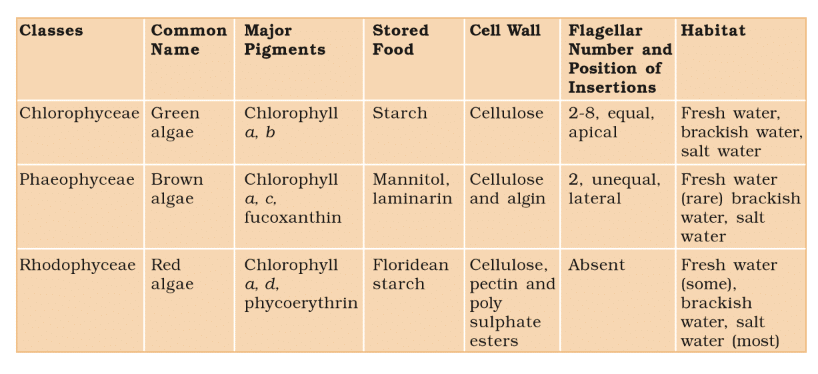
a) Chlorophyceae (Green Algae)
- Features: Grass green (chlorophyll a, b), varied chloroplasts (discoid, spiral, etc.), pyrenoids store starch/protein, cell wall (cellulose + pectose).
- Examples: Chlamydomonas, Volvox, Ulothrix, Spirogyra, Chara.
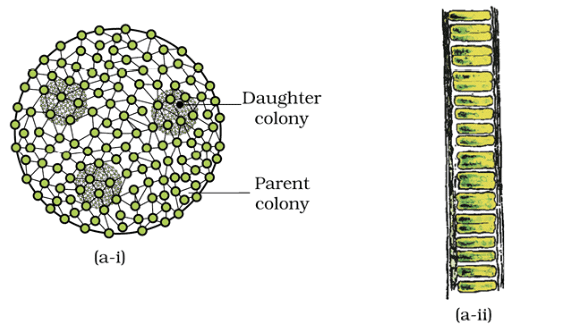 Green Algae (i) Volvox (ii) Ulothrix
Green Algae (i) Volvox (ii) Ulothrix
b) Phaeophyceae (Brown Algae)
- Features: Olive to brown (fucoxanthin), marine, holdfast/stipe/frond structure, biflagellate zoospores.
- Examples: Ectocarpus, Dictyota, Laminaria, Sargassum, Fucus.
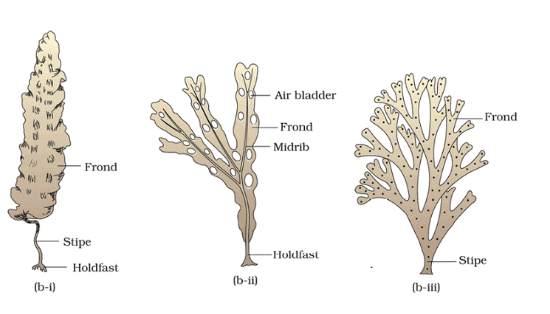 (b) Brown algae (i) Laminaria (ii) Fucus (iii) Dictyota
(b) Brown algae (i) Laminaria (ii) Fucus (iii) Dictyota
c) Rhodophyceae (Red Algae)
- Features: Red (r-phycoerythrin), multicellular, marine (deep/shallow), non-motile spores/gametes, oogamous.
- Examples: Polysiphonia, Porphyra, Gracilaria, Gelidium.
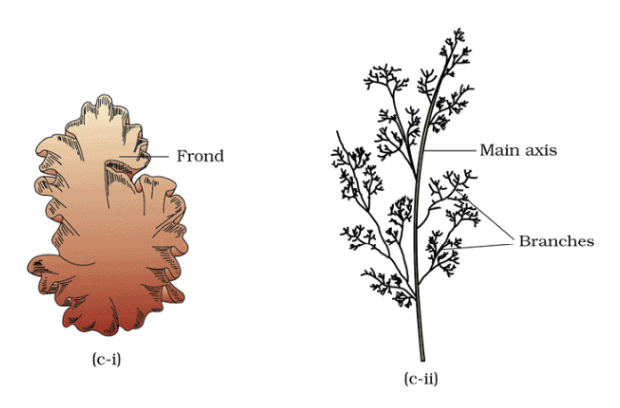 (c) Red algae (i) Porphyra (ii) Polysiphonia
(c) Red algae (i) Porphyra (ii) Polysiphonia
Bryophytes
Bryophytes (amphibians of plant kingdom) thrive in moist, shaded areas, requiring water for sexual reproduction, aiding plant succession on rocks/soil.
- Plant Body: Thallus-like, haploid gametophyte, attached by rhizoids, no true roots/stems/leaves.
- Life Cycle: Gametophyte produces antheridia (biflagellate antherozoids) and archegonia (single egg); zygote forms dependent sporophyte (foot, seta, capsule), releasing haploid spores via meiosis.
- Economic Importance: Peat (Sphagnum) for fuel/packing, ecological pioneers, soil erosion prevention.
1. Liverworts
- Features: Thalloid (e.g., Marchantia), dorsiventral, asexual via gemmae in gemma cups.
- Sporophyte: Foot, seta, capsule.
2. Mosses
- Features: Gametophyte in two stages—protonema (from spore) and leafy stage; elaborate sporophyte.
- Examples: Funaria, Polytrichum, Sphagnum.
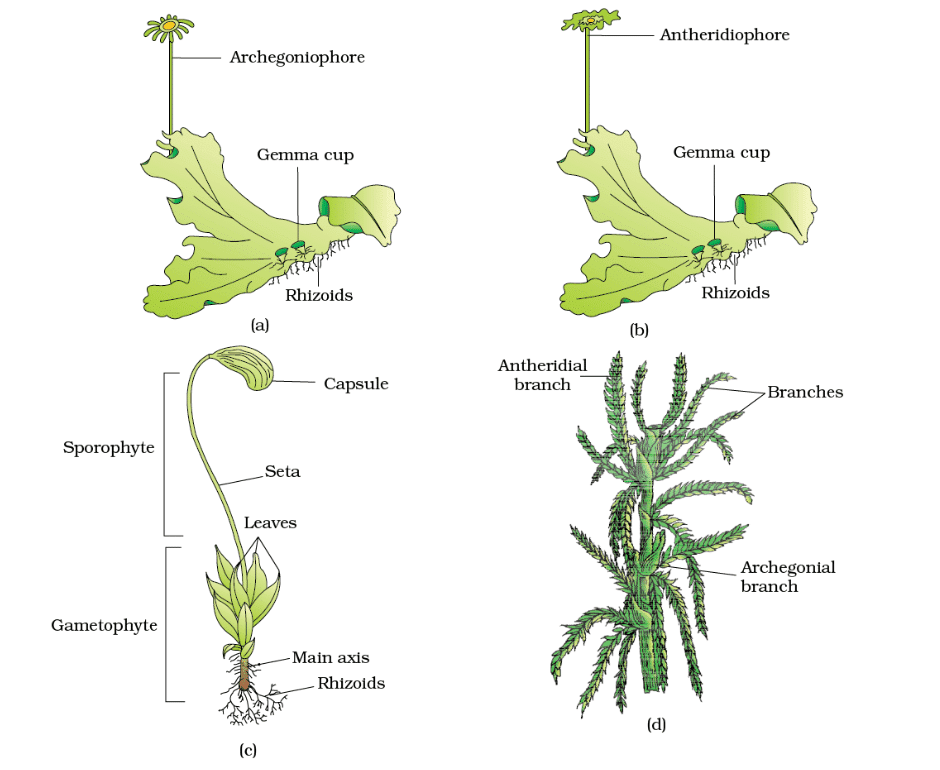 Bryophytes: A liverwort – Marchantia (a) Female thallus (b) Male thallus Mosses (c) Funaria, gametophyte and sporophyte (d) Sphagnum gametophyte
Bryophytes: A liverwort – Marchantia (a) Female thallus (b) Male thallus Mosses (c) Funaria, gametophyte and sporophyte (d) Sphagnum gametophyte
Pteridophytes
First terrestrial plants with vascular tissues (xylem, phloem), found in cool, damp areas, used medicinally and as ornamentals.
- Plant Body: Diploid sporophyte (true root, stem, leaves—microphylls/macrophylls), sporangia on sporophylls (sometimes in strobili).
- Life Cycle: Spores form prothallus (haploid gametophyte), bearing antheridia/archegonia; water needed for fertilization; zygote forms sporophyte.
- Types: Homosporous (one spore type) or heterosporous (macro/microspores, e.g., Selaginella, Salvinia—precursor to seed habit).
- Classes: Psilopsida (Psilotum), Lycopsida (Selaginella, Lycopodium), Sphenopsida (Equisetum), Pteropsida (Dryopteris, Pteris, Adiantum).
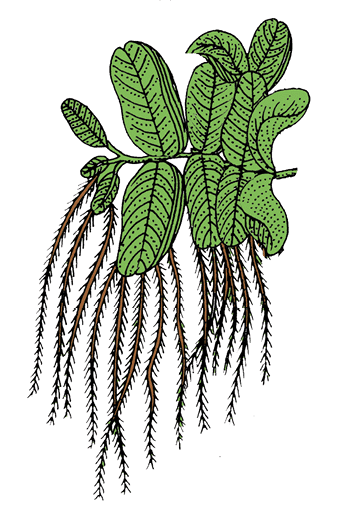
Salvinia
Gymnosperms
Gymnosperms have naked ovules/seeds, ranging from shrubs to tall trees (e.g., Sequoia).
- Features: Tap roots, mycorrhiza (Pinus), coralloid roots (Cycas), needle-like leaves (conifers) reduce water loss.
- Life Cycle: Heterosporous, microsporangia (male cones) produce pollen grains, megasporangia (female cones) form ovules; pollen tube aids fertilization; seeds uncovered.
- Examples: Cycas, Pinus, Ginkgo.
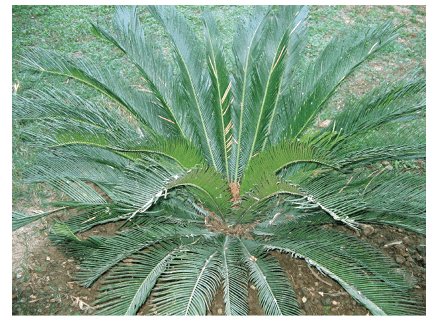
Angiosperms
Flowering plants with seeds enclosed in fruits, diverse in size (Wolffia to Eucalyptus), providing food, fodder, fuel, and medicines.
- Classes: Dicotyledons and monocotyledons.
 Angiosperms : (a) A dicotyledon (b) A monocotyledon
Angiosperms : (a) A dicotyledon (b) A monocotyledon
Summary
The Plant Kingdom includes algae (autotrophic, aquatic, three classes), bryophytes (amphibians, gametophyte dominant), pteridophytes (vascular, sporophyte dominant), gymnosperms (naked seeds), and angiosperms (enclosed seeds). Each group shows distinct life cycles and adaptations, reflecting evolutionary progression.
|
150 videos|401 docs|136 tests
|
FAQs on Revision Notes: Plant Kingdom - Biology Class 11 - NEET
| 1. What are the main divisions of the Plant Kingdom? |  |
| 2. What is the significance of photosynthesis in plants? |  |
| 3. How do bryophytes differ from pteridophytes? |  |
| 4. What are the characteristics of gymnosperms? |  |
| 5. Why are angiosperms considered the most advanced group of plants? |  |
















